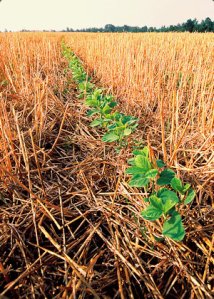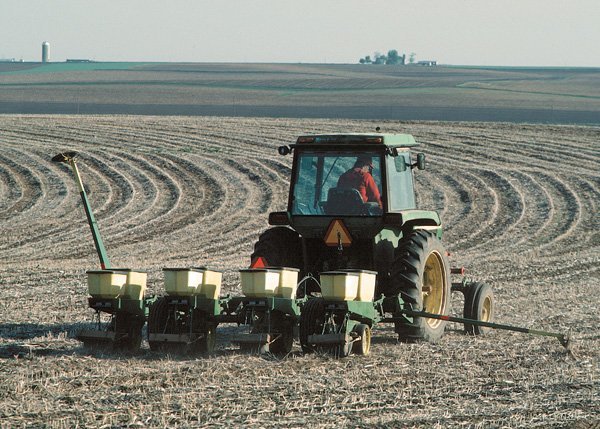
First, a little background. Farmers have plowed and tilled the soil for thousands of years. Sometimes they debated how often to plow, or how deep to plow, or what tool to use to plow. But they always plowed. Ancient Egyptian artwork portrays oxen pulling plows; many large breeds of horses and cattle arose in Europe to pull plows; and when the first settlers came to the Great Plains, professional sodbusters came with them for the sole purpose of operating plows.
As agricultural technology advanced in semi-arid areas such as western Kansas, people began to get really creative with the way they used their plows. Dry farming and “dust mulches” were the topics of the early 1900s. The idea was to thoroughly pulverize the soil to put it in the best possible condition for retaining moisture, and then to leave a loose covering of dust over the surface of the ground to act as a mulch. Frequent cultivation stirred up the dust mulch regularly to break up capillary action in the topsoil so that hopefully less water would be lost by evaporation. Many books were written on the subject, and the idea was hailed as the means by which the desert would blossom like a rose.
Then came the Dust Bowl.
The dust mulch was lifted up from the surface of the ground and carried into the sky, often coming down with the rain further east. Once the dust mulch was gone, nothing was protecting the rest of the soil, and it was carved away by the wind, little by little. Almost overnight dry farming, as it was practiced in that time, became something of a lost cause.
Once people began to recover from the shock, a few of them started asking questions. Obviously the dust mulch wasn’t a good idea. But what about exposed soil in general? Wasn’t it prone to being carried off by the wind, as well?
Why Do We Plow?
And then came a particularly interesting question: Why does everybody plow in the first place?
The reasons varied. Most farmers probably plowed because that’s what their granddaddies did. More scientific reasons included:
- Aeration.
- Killing weeds and pests.
- Turning in manure—green or otherwise.
But some people were still not convinced that plowing was the way to go. Nowhere in nature could they find an example of anything like conventional tillage. And so they began to experiment. The result was no-till farming.
Although no-till farming is still not the norm in America, it does have an ever-increasing following. Not only does it reduce wind-caused soil erosion, it also reduces evaporation of soil moisture to some degree. This is because plant residues on the surface of the ground are not tilled in, and therefore act as a mulch for the new crop.
How Conventional No-Till Farming Works

- Herbicides are applied to the field to kill the weeds or cover crop.
- A coulter or other cutting device slices a furrow into the soil.
- The planting equipment drops seeds into the narrow trench at the correct spacing.
- A press wheel closes the furrow over the seeds.
- More herbicides may be applied to kill weeds either before or after the crop sprouts.
Variations on a Theme
Many variations on the above process have been experimented with over the years, and little wonder. It took a major paradigm shift to convince farmers to give up plowing. Once that shift was made, small tweaks to the concept of no-till farming were quite natural. Many of these modifications have been attempts to reduce or eliminate the heavy use of herbicides conventional no-till relies on, while others are adaptations of the method for family garden use.
For example, organic gardeners have found that heavy mulching kills weeds without herbicides, while inviting earthworms to undertake the work of aeration. Others lay out permanent paths through the garden to avoid soil compaction in growing areas, and then use a broadfork or similar tool to loosen the dirt periodically. On a larger scale, organic farmers may plant thick cover crops and mow or crimp them down when mature enough, leaving the residue on the surface of the soil to smother weeds.
Other farmers have compromised between till and no-till philosophy. Some may till rotationally, meaning that they will completely till the field every other year or so. A few strip-till, only turning up rows eight to ten inches wide.
Although there is a great deal of variety in these different tillage systems, they all share a common goal: soil conservation. Furthermore, they offer a wide range of ways to achieve this goal, giving farmers the flexibility to adapt to their unique circumstances.
Helpful Resource
Pros and Cons of No-Dig Gardening
Considering adapting no-till to your home garden? Here’s what you need to know.

